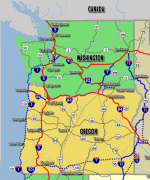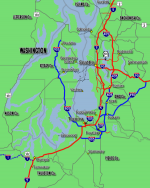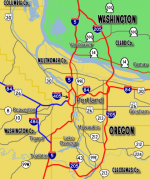Ultimate Interstates:Pacific Northwest: Difference between revisions
No edit summary |
|||
| (3 intermediate revisions by the same user not shown) | |||
| Line 9: | Line 9: | ||
The route would largely replace US 101 throughout most of the state. However through the bay area it would replace I-880 along the east bay and cross using the San Rafael bridge (I-580) which is where it would route back over to back to the US-101 alignment northward. | The route would largely replace US 101 throughout most of the state. However through the bay area it would replace I-880 along the east bay and cross using the San Rafael bridge (I-580) which is where it would route back over to back to the US-101 alignment northward. | ||
[[Ultimate Interstates:Corridor 1|Main Article]] | [[Ultimate Interstates:Corridor 1|Main Article]] | ||
==[[Ultimate Interstates:Corridor 7|Corridor 7]]== | |||
This project would Upgrade US-395 from I-182 in Pasco to I-90 near Ritzville to interstate standards and sign as Ultimate Interstate 7. and would also create a new western bypass to connect to I-82 south of the Tri-Cities metro area. providing a more direct connection from Portland and I-5 to Spokane and Coeur D'alene and the I-90 corridor. This route would also fit nicely into the overall interstate plan. | |||
[[Ultimate Interstates:Corridor 7|Main Article]] | |||
==[[Ultimate Interstates:Corridor 11|Corridor 11]]== | ==[[Ultimate Interstates:Corridor 11|Corridor 11]]== | ||
| Line 32: | Line 38: | ||
[[Ultimate Interstates:Eugene Interstate Spurs|Main Article]] | [[Ultimate Interstates:Eugene Interstate Spurs|Main Article]] | ||
==[[Ultimate Interstates:Seattle Metro|Seattle Metro]]== | |||
Seattle Metro could benefit from the upgrade of some of its freeways to interstate designations as a way of promoting interstate continuity with the greater system. This plan largely involves changing the route designation on several routes to interstate routes mostly serving the southern part of the metro area. | |||
[[Ultimate Interstates:Seattle Metro|Main Article]] | |||
[[Category:Ultimate Interstates]][[Category:Visions]][[Category:Western US]] | [[Category:Ultimate Interstates]][[Category:Visions]][[Category:Western US]] | ||
Latest revision as of 12:11, 1 October 2020



Oregon and Washington would see a number of interstate improvements. The maps show these various improvements. Solid Blue Lines indicate new free and purple indicates toll interstate routes. Dotted lines show additional Proposed routes or alternative routes. Red lines show existing Interstate highways.
Corridor 1
Ultimate Interstate 1 is an interstate highway corridor that travels up the California Coastline from Los Angeles to San Francisco. This route could also be extended northward along the Oregon and Washington coastline to Olympia, WA.
The route would largely replace US 101 throughout most of the state. However through the bay area it would replace I-880 along the east bay and cross using the San Rafael bridge (I-580) which is where it would route back over to back to the US-101 alignment northward.
Corridor 7
This project would Upgrade US-395 from I-182 in Pasco to I-90 near Ritzville to interstate standards and sign as Ultimate Interstate 7. and would also create a new western bypass to connect to I-82 south of the Tri-Cities metro area. providing a more direct connection from Portland and I-5 to Spokane and Coeur D'alene and the I-90 corridor. This route would also fit nicely into the overall interstate plan.
Corridor 11
Originating from Gila Bend, Arizona I-11 travels north into Nevada crossing the new Colorado River Bridge near the Hoover Dam. This interstate would replace existing US-93 and I-515 south of Las Vegas. North of Las Vegas the route will generally follow US-95 northward throughout the state north through Fallon. I-11 would be cosigned with I-80 from Fallon Junction to Winnemucca before continuing north along US-95 into Oregon. Eventually the route continues north toward Boise and Lewiston eventually ending in Spokane.
I-84 Extension
This project would Extend I-84 west from its existing terminus at I-5 in Portland westward to Seaside following the US-26 Sunset Highway route to the west.
Southern Oregon Corridor
This is a conceptual option to construct an interstate highway along the southern part of Oregon linking I-84 near Ontario, OR to I-5 near Medford, OR. The routing could also branch off from Corridor 11 near Burns Junction (depending on if I-11 is built). Whether such a corridor would ever be considered remains to be seen. If built this interstate would open up interstate commerce to the south central part of Oregon, most of which is currently served by 2 lane highways. The largest city serviced by the corridor would be Klamath Falls.
Eugene Interstate Spurs
This would be a 2 pronged plan to add additional interstate miles to the Eugene Metro area. This would be accomplished by extending I-105 eastward along OR-126 to east of Springfield OR, and by redesignating the Beltline Highway (OR-569) as I-305 and upgrading the western segment to full interstate standards.
Seattle Metro
Seattle Metro could benefit from the upgrade of some of its freeways to interstate designations as a way of promoting interstate continuity with the greater system. This plan largely involves changing the route designation on several routes to interstate routes mostly serving the southern part of the metro area.